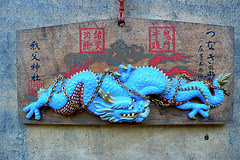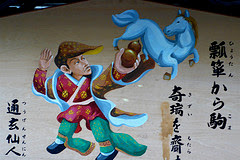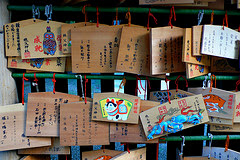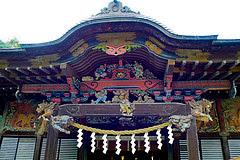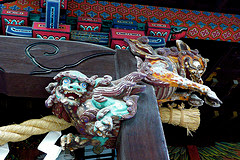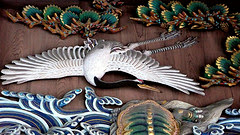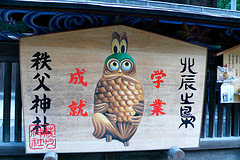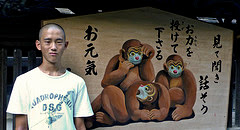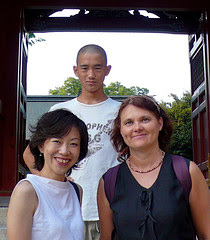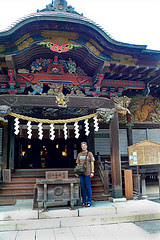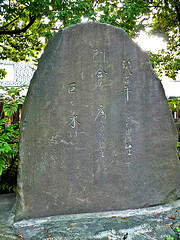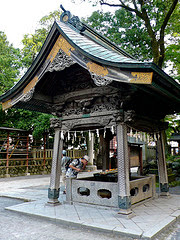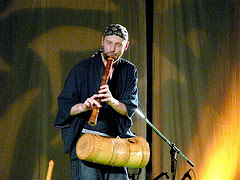
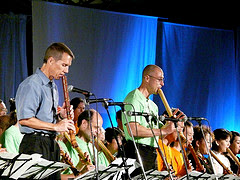




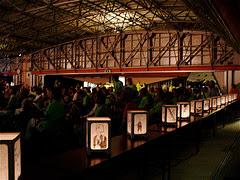
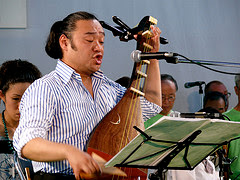
The full set of photos may be found on flickr in the Bisei Festival set.
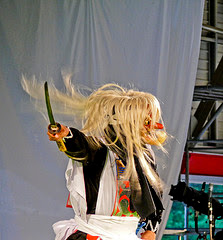 The Bisei festival marked the 20th anniversary of the festival of the International Shakuhachi Kenshukan (Educational institution), founded by Katsuya Yokoyama, a tradition continued this year by his students, all long-established masters themselves: Teruo Furuya, Kazushi Matama, Kuniyoshi Sugawara, Akikazu Nakamura, Ichro Seki, Toshimitsu Ishikawa, Michiaki Okada, Yoichi Iwahashi, Kaoru Kakizakai, especially with the organisational direction of Furuya, Matama and Kakizakai. The weekend (24-26 August in high summer) took place in an old schoolhouse and its associated classrooms, once acquired by Yokoyama to host the Kenshukan events. It is in a remote part of Western Honshu near to Hiroshima, nearly 4 hours by shinkansen from Tokyo. The nearest major shinkansen (bullet train) junction is Okayama station. From there a local train and chartered bus took us to the setting amongst agricultural lands, climbing up high mountainous terrain and through clusters of small village houses spread between rice, grapes and other crop farming. Bisei is otherwise well-known as the optimal star-viewing site in Japan, dotted with many oberservatories taking advantage of its high clear skies, away from city, pollution and smog.
The Bisei festival marked the 20th anniversary of the festival of the International Shakuhachi Kenshukan (Educational institution), founded by Katsuya Yokoyama, a tradition continued this year by his students, all long-established masters themselves: Teruo Furuya, Kazushi Matama, Kuniyoshi Sugawara, Akikazu Nakamura, Ichro Seki, Toshimitsu Ishikawa, Michiaki Okada, Yoichi Iwahashi, Kaoru Kakizakai, especially with the organisational direction of Furuya, Matama and Kakizakai. The weekend (24-26 August in high summer) took place in an old schoolhouse and its associated classrooms, once acquired by Yokoyama to host the Kenshukan events. It is in a remote part of Western Honshu near to Hiroshima, nearly 4 hours by shinkansen from Tokyo. The nearest major shinkansen (bullet train) junction is Okayama station. From there a local train and chartered bus took us to the setting amongst agricultural lands, climbing up high mountainous terrain and through clusters of small village houses spread between rice, grapes and other crop farming. Bisei is otherwise well-known as the optimal star-viewing site in Japan, dotted with many oberservatories taking advantage of its high clear skies, away from city, pollution and smog.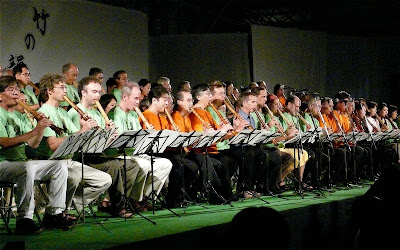
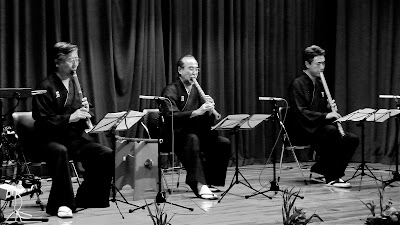
The great shakuhachi ensemble in the public Bisei community concert and the Kenshukan: Furuya, Matama and Kakizakai in the teachers'concert. [Click on image for a larger view].
International teachers included: Riley Lee (Australia/World Shakuhachi Festival 2008), Michael Coxall, Veronique Piron (France/European Shakuhachi Society), Kiku Day (Denmark/UK/European Shakuhachi Society/jinashi specialist), Tim Hoffman (Indo-Japanese cross-over music), David Wheeler, Peter Hill, John Kaizan Neptune (bamboo instruments - and home page), Jim Franklin, Marco Lienhard, and Bruce Huebner.

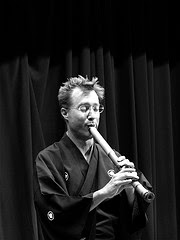
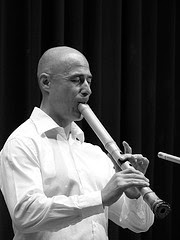
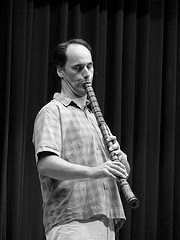
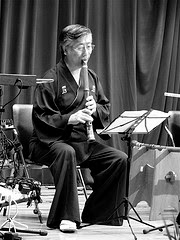

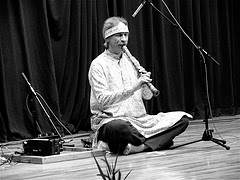
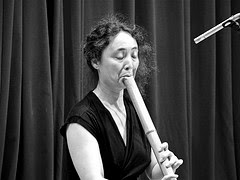
Teachers' concert: Veronique Piron (France) playing contemporary repertoire, Bruce Huebner (pictured) playing Shika no Tone with David Wheeler, Riley Lee playing Ross Edwards' Raft Song at Sunrise, Marco Lienhard, Teruo Furuya playing Sanan, Peter Hill playing Sokkan, Tim Hoffman playing Indian raga cross-over music on shakuhachi, and Kiku Day specialising in jinashi instruments.
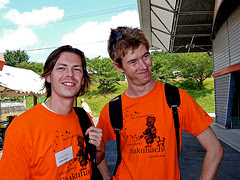 Helpers included students of the Kenshukan, such as Lachlan and Joshua Smith. The staff and assistants are wearing the orange shirts in the photos while the participants are wearing green. Accommodation involved rolling out futons on the tatami classroom floor for night-time, stored again during the day so we could practice there. The attendance was amazing: around 130 participants who crowded into one giant teaching room for massed tutorials and occasionally split off into smaller groups for ensemble practice or repertoire on 2.4-lengthed shakuhachi and other variations.
Helpers included students of the Kenshukan, such as Lachlan and Joshua Smith. The staff and assistants are wearing the orange shirts in the photos while the participants are wearing green. Accommodation involved rolling out futons on the tatami classroom floor for night-time, stored again during the day so we could practice there. The attendance was amazing: around 130 participants who crowded into one giant teaching room for massed tutorials and occasionally split off into smaller groups for ensemble practice or repertoire on 2.4-lengthed shakuhachi and other variations. 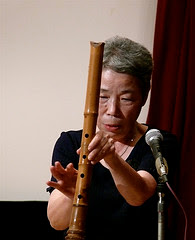 Sleeping was impossibly hot in rooms of 30+ people and some determined to practise until 4am or take advantage of the social situation but everyone remained cheerful and energetic nonetheless. The showers/bath were guarded by super-sized mosquitos waiting opportunistically! On the first evening, we had a presentation on the history, context and origins of shakuhachi by an eminent Japanese musicologist, followed by a symposium by the International (English-language) staff of the festival discussing a range of issues relating to the contemporaneous shakuhachi scene around the globe.
Sleeping was impossibly hot in rooms of 30+ people and some determined to practise until 4am or take advantage of the social situation but everyone remained cheerful and energetic nonetheless. The showers/bath were guarded by super-sized mosquitos waiting opportunistically! On the first evening, we had a presentation on the history, context and origins of shakuhachi by an eminent Japanese musicologist, followed by a symposium by the International (English-language) staff of the festival discussing a range of issues relating to the contemporaneous shakuhachi scene around the globe.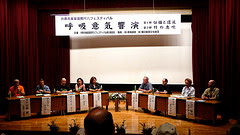 Japanese women with whom I shared a room, included Sakura-i, Kaneko, Takasu, Hirayama (and about 25 others). For the most part, it was quite daunting that most people had played already for 10-20 years and it was common enough to discover players who had been persevering at shakuhachi for over 30 years! It this context, many of the Australian and other International strudents were real novices, Rob and I perhaps amongst the newest.
Japanese women with whom I shared a room, included Sakura-i, Kaneko, Takasu, Hirayama (and about 25 others). For the most part, it was quite daunting that most people had played already for 10-20 years and it was common enough to discover players who had been persevering at shakuhachi for over 30 years! It this context, many of the Australian and other International strudents were real novices, Rob and I perhaps amongst the newest.  Naturally, the technical and musical standard was very high and motivating. It was a rare and priveleged opportunity to meet so many true 'world greats' in one location - we were extremely fortunate. The tutorials therefore moved along at a rapid pace and essentially introduced and polished pieces that we had prepared before arrival. Interesting discussion/masterclass sessions such as Nakamura's cyclical breathing (bizarre) technical exposition or John Kaizan Neptune's excellent reinforcement of quality pratice techniques and exercises for developing dexterity, fluency and agility were very helpful punctuations to the rehearsal sessions working towards an ensemble public concert. The teachers, including the International performers, Kenshukan and Japanese musicians on instruments other than shakuhachi - koto, biwa, voice, taiko (played by Marco in ensemble) - delivered an outstanding solo/chamber teachers-only concert and the public ensemble concert, attracting around 2000 people from local Bisei, in which we all participated in some massed ensemble pieces for shakuhachi or shakuhachi with koto. It was a spectacle to see so many shakuhachi players on stage in one location and maybe 8+ koto players, bass koto, etc. The evening public concert was a family affair with entertaining jazz fusion pieces by John Neptune with guitar and lighting effects, dramatic sword-dances by costumed actors and an array of styles from traditional through to modern Japanese music and the aforementioned cross-over and fusion types. All events were filmed and recorded with Japanese technical panache.
Naturally, the technical and musical standard was very high and motivating. It was a rare and priveleged opportunity to meet so many true 'world greats' in one location - we were extremely fortunate. The tutorials therefore moved along at a rapid pace and essentially introduced and polished pieces that we had prepared before arrival. Interesting discussion/masterclass sessions such as Nakamura's cyclical breathing (bizarre) technical exposition or John Kaizan Neptune's excellent reinforcement of quality pratice techniques and exercises for developing dexterity, fluency and agility were very helpful punctuations to the rehearsal sessions working towards an ensemble public concert. The teachers, including the International performers, Kenshukan and Japanese musicians on instruments other than shakuhachi - koto, biwa, voice, taiko (played by Marco in ensemble) - delivered an outstanding solo/chamber teachers-only concert and the public ensemble concert, attracting around 2000 people from local Bisei, in which we all participated in some massed ensemble pieces for shakuhachi or shakuhachi with koto. It was a spectacle to see so many shakuhachi players on stage in one location and maybe 8+ koto players, bass koto, etc. The evening public concert was a family affair with entertaining jazz fusion pieces by John Neptune with guitar and lighting effects, dramatic sword-dances by costumed actors and an array of styles from traditional through to modern Japanese music and the aforementioned cross-over and fusion types. All events were filmed and recorded with Japanese technical panache.
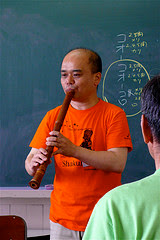
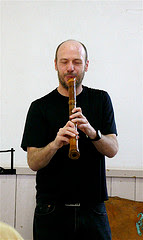
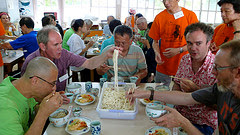
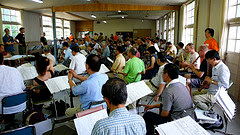
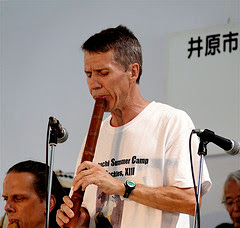 Meals were variously catered, ranging from Bento (lunch boxes) to noodles, fishy breakfast and tempura served in a large kitchen and ravinously devoured between rehearsals and concerts. It was great to see people attracted from such a diversity of traditions (such as Koten, Kinko, Tozan), teachers, countries and disparate locations in Japan, all ostensibly linked in some way to the homage of Katsuya Yokoyama. Perhaps the most disappointing aspect was that Yokoyama himself, who has been unwell, was not able to attend the festival as we had hoped. He is the surrogate 'father'of this extended family of shakuhachi players - disciples of him and his students, now longtime teachers themselves.
Meals were variously catered, ranging from Bento (lunch boxes) to noodles, fishy breakfast and tempura served in a large kitchen and ravinously devoured between rehearsals and concerts. It was great to see people attracted from such a diversity of traditions (such as Koten, Kinko, Tozan), teachers, countries and disparate locations in Japan, all ostensibly linked in some way to the homage of Katsuya Yokoyama. Perhaps the most disappointing aspect was that Yokoyama himself, who has been unwell, was not able to attend the festival as we had hoped. He is the surrogate 'father'of this extended family of shakuhachi players - disciples of him and his students, now longtime teachers themselves.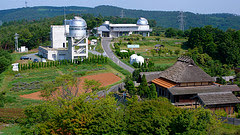
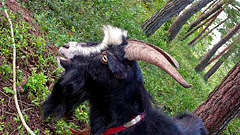


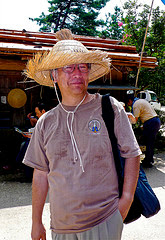

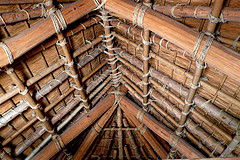
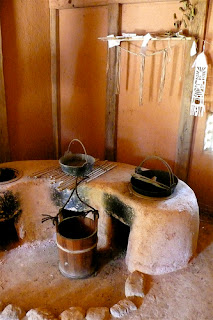 After all the concerts were over, festivities and celebrations were manifest in the final party night of tribute, thanks and (of course) eating, drinking and philosophical discussions well into the night. Bill and I walked down to the village farmers' market for breakfast - on-demand cooked tempura prawn and udon amongst the fruit, veg and already tempting ice-cream as the hot morning broke. Our last activity on the final day, was a visit to a culture/nature park that meandered through bushland (is that what it would be called in Japan? - maybe light woods and grassland) in which traditional homes from previous centuries with giant straw rooves and traditonal craftwork were exhibitied - such as blacksmithing or toolmaking, Takahashi-san taught shakuhachi-making from PVC tubing, people sat themselves in various outdoor settings and played to passers-by, weaving looms were on display, a few domestic billy-goats, a watch-tower with picturesque outlook over the surrounding countryside from which several people performed the Shika no Tone duet between two 'deer'calling out across the landscape, and an observatory.
After all the concerts were over, festivities and celebrations were manifest in the final party night of tribute, thanks and (of course) eating, drinking and philosophical discussions well into the night. Bill and I walked down to the village farmers' market for breakfast - on-demand cooked tempura prawn and udon amongst the fruit, veg and already tempting ice-cream as the hot morning broke. Our last activity on the final day, was a visit to a culture/nature park that meandered through bushland (is that what it would be called in Japan? - maybe light woods and grassland) in which traditional homes from previous centuries with giant straw rooves and traditonal craftwork were exhibitied - such as blacksmithing or toolmaking, Takahashi-san taught shakuhachi-making from PVC tubing, people sat themselves in various outdoor settings and played to passers-by, weaving looms were on display, a few domestic billy-goats, a watch-tower with picturesque outlook over the surrounding countryside from which several people performed the Shika no Tone duet between two 'deer'calling out across the landscape, and an observatory. Someone dressed up as a komuso (traditionally-inspired wandering shakuhachi-playing monk) with tengei (basket) head-dress
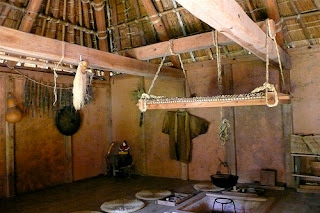
and wandered about while others played chamber pieces to passing public and an excusrion of school children. After a final toast and promises to meet again at the World Shakuhachi Festival in Sydney in July 2008, or Rockies Camp 'Down Under', we dispersed on various trains and buses, planes.

